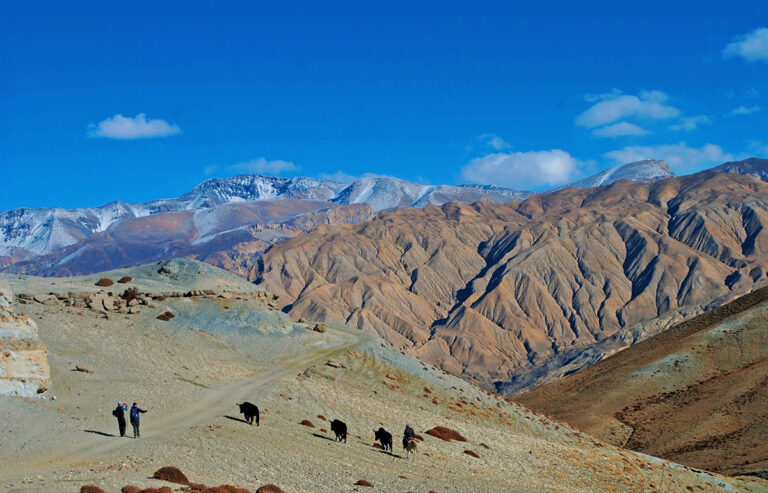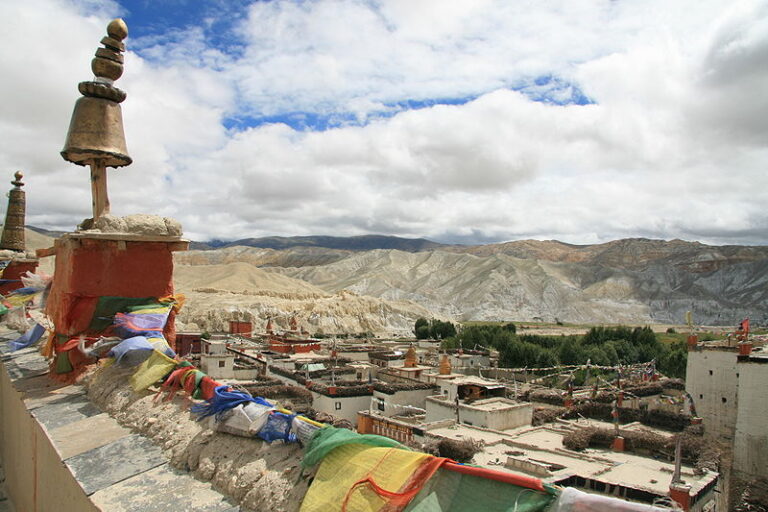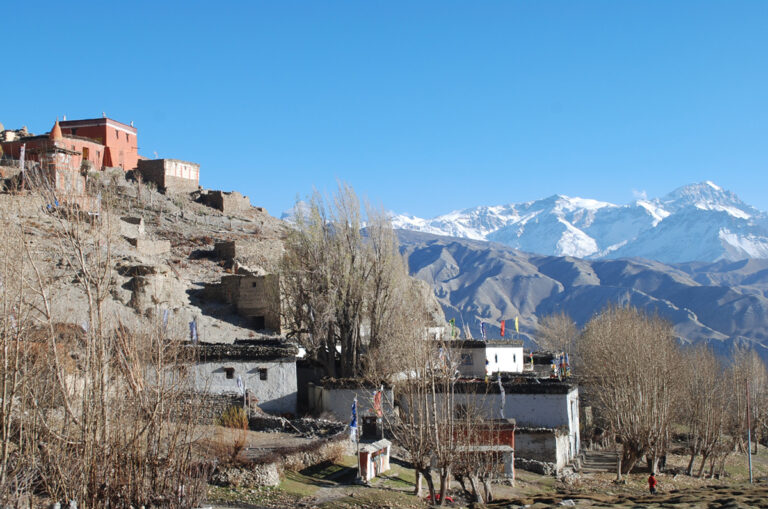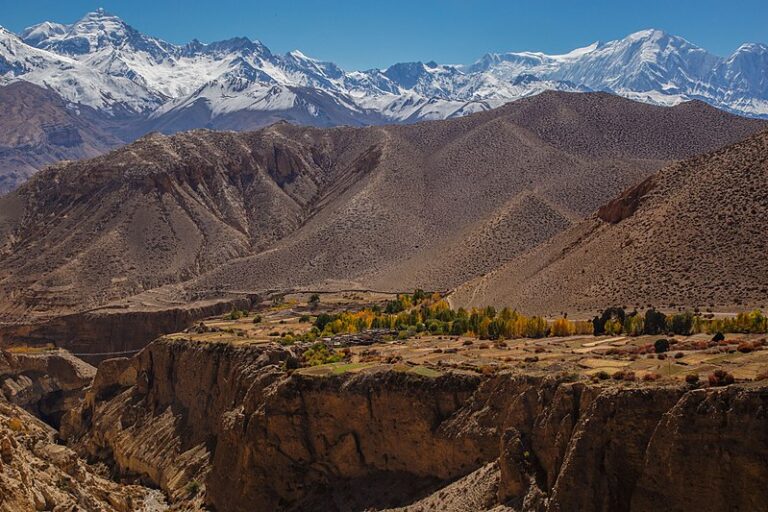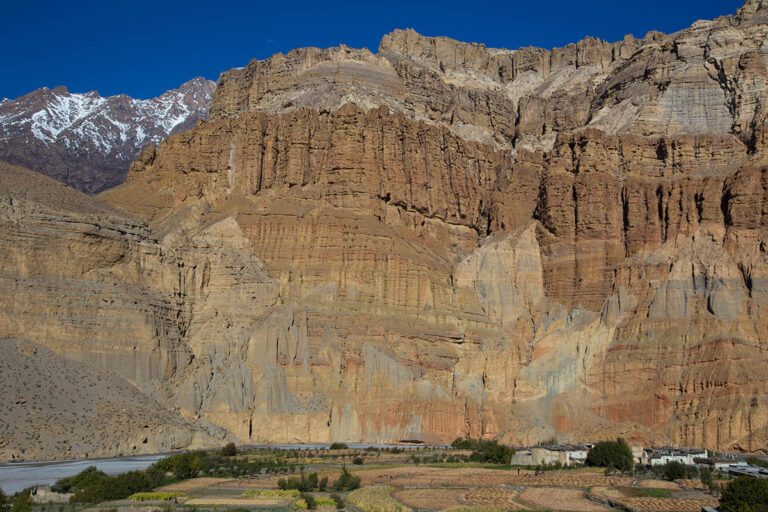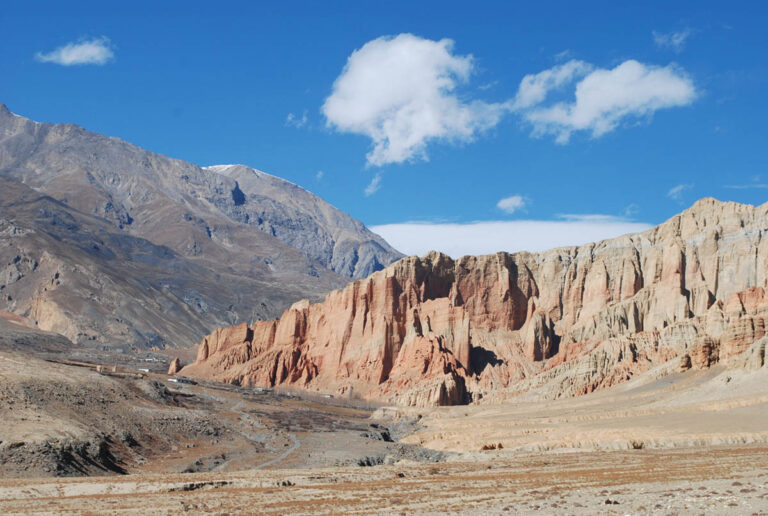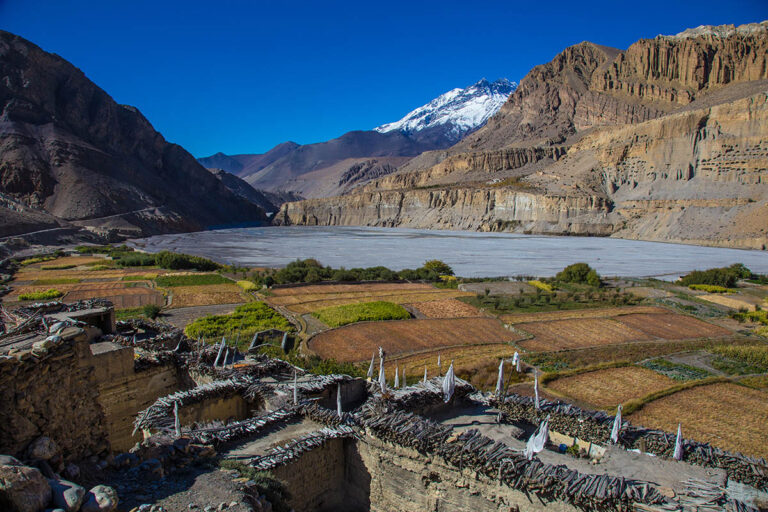Day 01 – Pick up from the Tribhuwan International Airport of Kathmandu on your arrival date and transfer to the hotel.
Day 02 – Sightseeing to the historical and ancient places around the Kathmandu valley like Pashupatinath temple, Baudhanath stupa, Patan Durbar square and Swayambhunath; which is also known as monkey temple.
Day 03 – Drive to Pokhara and trek preparation – we will drive for approximately 7 hours to get Pokhara passing by many towns and villages which are settled just on the bank of the Trisuli river with the beautiful view of Manaslu and the Annapurna mountain range. When we will get to Pokhara we will do a trekking preparation and the guide will give to the participants a briefing about the trekking plan.
Day 04 – fly to Jomsom and trek to Kagbeni village 2858m – early in the morning we will fly 25 minutes to get Jomsom village, which is part of the Mustang region called lower Mustang. The Jomsom village will offers you to see stunning views of Nilgiri, the Muktinath peak, the Tukuche peak and its beautiful ranges. From the Jomsom village, we will trek on the bank of the Kali Gandaki River for approximately 3 hours to get the Kagbeni village.
Day 05 – Trek to Chele (3050m.a.s.l) – 5 hours walk – we will head to the North-west of Kali Gandaki river valley, ascending by the gradual trail on the gigantic deserted land. After one and a half hours walk from Kagbeni village appear the Tangbe village where can be seen traditional houses, apple orchards, old Stupa and Chortens. The narrow valley will lead us to Chhuksang which surrounded by a huge red cliff that commands to see dozens of sky caves, dog on a vertical cliff.
Day 06 – Trek to Syangbochen (3475m.a.s.l) – 6 hours walk – The trail gently ascends from the yard of the guesthouse of the Chele for 2 hours, before to get to a hilltop called Taklam-La pass (3624m). This hilltop allows us seeing the view the Tilicho peak, Yakyakang, Damodar Danda and a beautiful view of the Kali Gandaki river gorge to the downwards. After the Taklam-La pass, we will trek on a flat trail for about 20 minutes to get to the Samar village and we will climb up for approximately three hours to get to the Syangbochen village, walking through the Juniper, a bushy trail, with a charming landscape’s view.
Day 07 – Trek to Ghami village (3520m.a.s.l) – 6 to 7 hours walk – Today we will cross two small passes called Nyi-La pass, 4020 meters, and Ghami-La 3765 meters. From the top of the pass we will head towards Ghami village with magnificent view of Annapurna, Nilgiri and Damodar peak to the east and superb view of deserted landscapes to the all direction. Beyond the mountains and landscapes views we will see hundreds of Chhortens, Stupa, Kani gates, longest Mani walls of the region and as well as sky caves; which are dug on a vertical cliff.
Day 08 – Trek to Tsarang (3560m.a.s.l) – 5 hours walk – At the beginning of the trek we will walk downhill trail about 20 minutes to get the Ghami stream and then the trail ascend to the Chingel or Choya-La pass (3870 meters). Most of the time we will walk on the gradual trail pass by several small hills with the view of charms landscapes, Kali Gandaki River gorge, snow-capped peaks and a long Mani wall which is built just center of the trekking trail. The major attraction of the day would be the view of a cliff or hill, which seems to be made of gold with wonderful formation. There are half dozens of teahouses in Tsarang village where we will spend our joyful night with great hospitality of Tibetan people.
Day 09 – Trek to Lo-Manthang (3840m.s.l) – 5 hours walk – The trek from Tsarang to Lo-Manthang would be very pleasant and memorable of the trip due to easy walk and nature views. The trail leads us through the gigantic pastureland where can be seen thousands of grazing yaks, Horses, sheep and mountain goats. After three and half hours walk we will be top of the hill also called Lodya La (pass 3950m) that commands us to see numerous of snow-capped mountains, awesome landscapes, sky caves and as well as beautiful view of Lo-Manthang village. There are dozens of guesthouses in Lo-Manthang to spend a pleasant night.
Day 10 – Exploration around the Lo-Manthang or sight trip to Chhoser village. There are many old monasteries around the Lo-Manthang village. Among of them; ancient royal palace, Jampa Gompa, Thubchen Gompa and Chhyode Gompa are the major attractions of the village because of their ancient origin and traditional architecture. Most of the monasteries were built early in the 15th century using by only clay, stones and wooden log. Apart of the old monasteries there are hundreds interesting things to see such as Mani walls, Stupa, Kani gates, Chhortens, Tiny streets and traditional houses; which are well decorated with colorful Buddhist prayer flag.
Day 11 – Trek to Dhakmar village (3820m.a.s.l) – 7 hours walk – we will take alternative route to get Dhakmar village instead of main trekking trail. At the beginning; we will follow the main trekking trail for half and hour to get top of the Lodya-La pass then the trail turn to the left side and leads towards Dhakmar. Today we have to walk uphill trail and have to cross three hillocks called Pangga samduling 4090m, Marang (Chogo) La 4230m and Muila Bhanjyang 4170 meters so we will have endless nature views, wild life and some of the landmarks of Upper Mustang known as Pangga Samduling and Ghar Monastery which is believed to be more than 1200 years old.
Day 12 – Trek to Ghiling (3806m.a.s.l) – 6 hours walk – Today we return back to the Ghiling village which is a beautiful hamlet settled just on bottom of the hill located nearby a small stream. Most of the time, we will trek downhill trail until Ghami village then the trail ascend to the Nyi La pass (4020m) with delightful views of snow-capped mountains and enormous landscapes. From the top of the Myi La pass we will walk down to Ghiling village through the juniper forest. Juniper is one of the most important plants for the local people, using as incense to invite deities and as a votive element to ask auspicious to start good work.
Day 13 – Trek to Chhuksang (3050m.a.s.l) – 7 hours walk – At the beginning of the trek we will ascend for approximately two hours to get Yamda La pass which is 4010 meters high and commands to see striking views of Nilgiri, Damodar Danda, Phalkang peak, Penchi thanka peak and as well as superb view of kali Gandaki River valley. After sight of this fascinating view; we will head towards Chhuksang pass by Somar, Ghyakar and Chele village.
Day 14 – Trek to Jomsom village (2700m.a.s.l) – 7 hours walk – The trail leads us just bank of the Kali Gandaki River and commands us to see beautiful Kali Gandaki River valley, rugged rocky hills, snow-capped mountains known as Muktinath peak, Yakawakang, Thorong peak, Tukuche peak, Thapa peak and including stunning view of mount Dhaulagiri. We will have our lunch in Kagbeni village; which is main entrance gate to go upper Mustang and a ancient Tibetan settlement and offers to explore a beautiful monastery.
Day 15 – fly or drive back to Pokhara – The road has been developed from Jomsom to Pokhara so we can drive either bus or private jeep to get Pokhara; which may takes whole day. If we have tight schedule then we can take 25 minute scenic flight and we can hang around the Pokhara Street in the afternoon.
Day 17 – fly back to Kathmandu and final departure.
